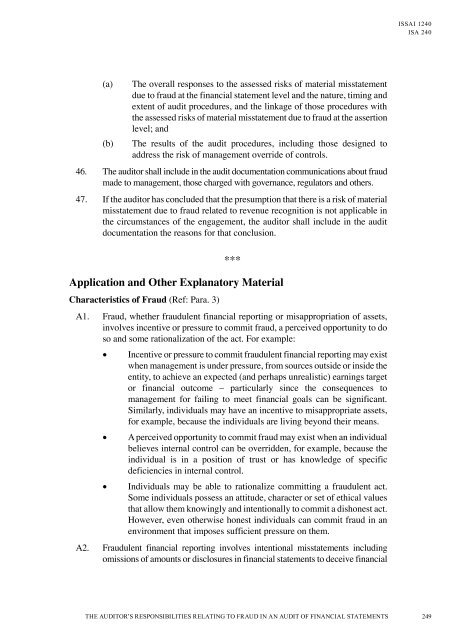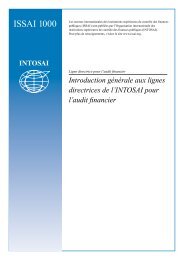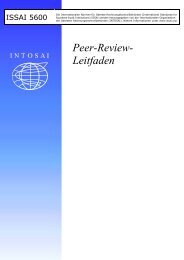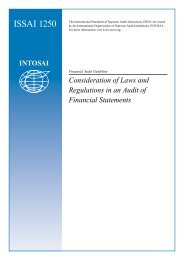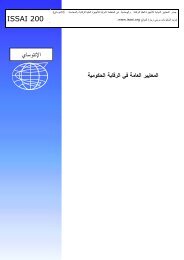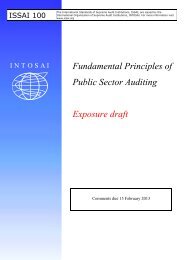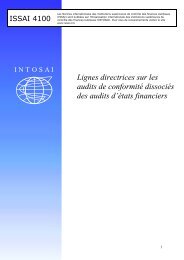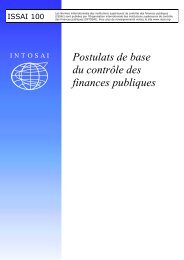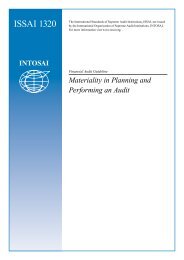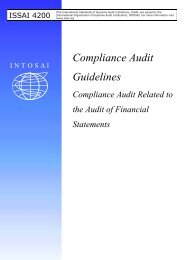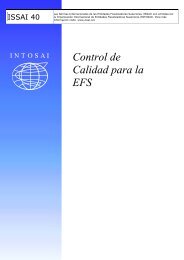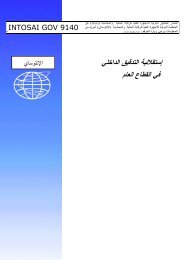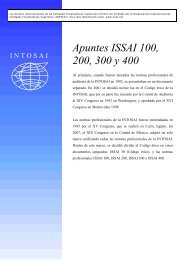ISSAI 1240
ISSAI 1240
ISSAI 1240
Create successful ePaper yourself
Turn your PDF publications into a flip-book with our unique Google optimized e-Paper software.
<strong>ISSAI</strong> <strong>1240</strong><br />
ISA 240<br />
THE AUDITOR’S RESPONSIBILITIES RELATING TO<br />
FRAUD IN AN AUDIT OF FINANCIAL STATEMENTS<br />
(a)<br />
(b)<br />
The overall responses to the assessed risks of material misstatement<br />
due to fraud at the financial statement level and the nature, timing and<br />
extent of audit procedures, and the linkage of those procedures with<br />
the assessed risks of material misstatement due to fraud at the assertion<br />
level; and<br />
The results of the audit procedures, including those designed to<br />
address the risk of management override of controls.<br />
46. The auditor shall include in the audit documentation communications about fraud<br />
made to management, those charged with governance, regulators and others.<br />
47. If the auditor has concluded that the presumption that there is a risk of material<br />
misstatement due to fraud related to revenue recognition is not applicable in<br />
the circumstances of the engagement, the auditor shall include in the audit<br />
documentation the reasons for that conclusion.<br />
***<br />
Application and Other Explanatory Material<br />
Characteristics of Fraud (Ref: Para. 3)<br />
A1. Fraud, whether fraudulent financial reporting or misappropriation of assets,<br />
involves incentive or pressure to commit fraud, a perceived opportunity to do<br />
so and some rationalization of the act. For example:<br />
• Incentive or pressure to commit fraudulent financial reporting may exist<br />
when management is under pressure, from sources outside or inside the<br />
entity, to achieve an expected (and perhaps unrealistic) earnings target<br />
or financial outcome – particularly since the consequences to<br />
management for failing to meet financial goals can be significant.<br />
Similarly, individuals may have an incentive to misappropriate assets,<br />
for example, because the individuals are living beyond their means.<br />
• A perceived opportunity to commit fraud may exist when an individual<br />
believes internal control can be overridden, for example, because the<br />
individual is in a position of trust or has knowledge of specific<br />
deficiencies in internal control.<br />
• Individuals may be able to rationalize committing a fraudulent act.<br />
Some individuals possess an attitude, character or set of ethical values<br />
that allow them knowingly and intentionally to commit a dishonest act.<br />
However, even otherwise honest individuals can commit fraud in an<br />
environment that imposes sufficient pressure on them.<br />
A2. Fraudulent financial reporting involves intentional misstatements including<br />
omissions of amounts or disclosures in financial statements to deceive financial<br />
14<br />
The Auditor’s Responsibilities Relating to Fraud in an Audit of Financial Statements 249


